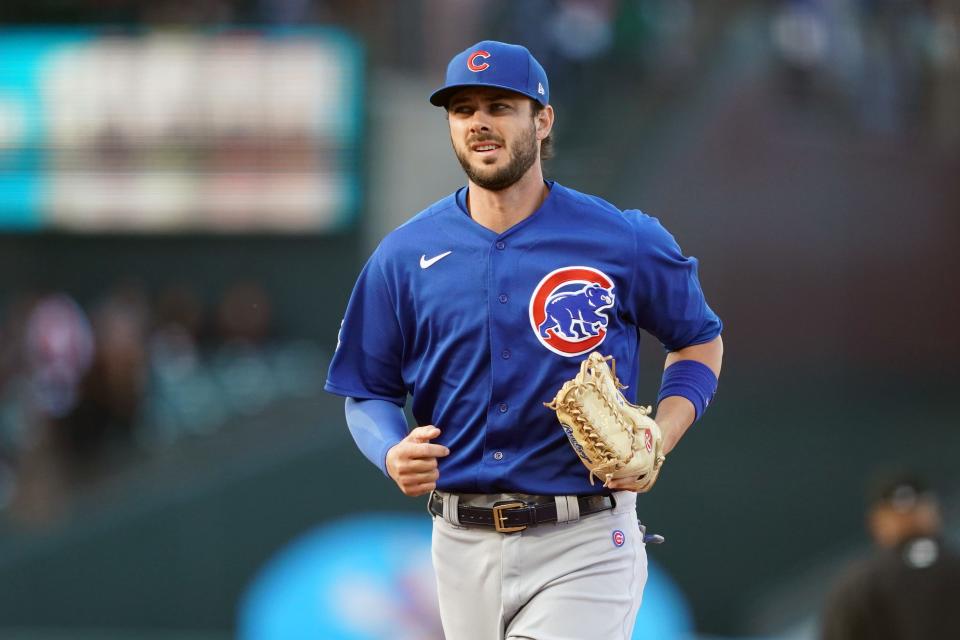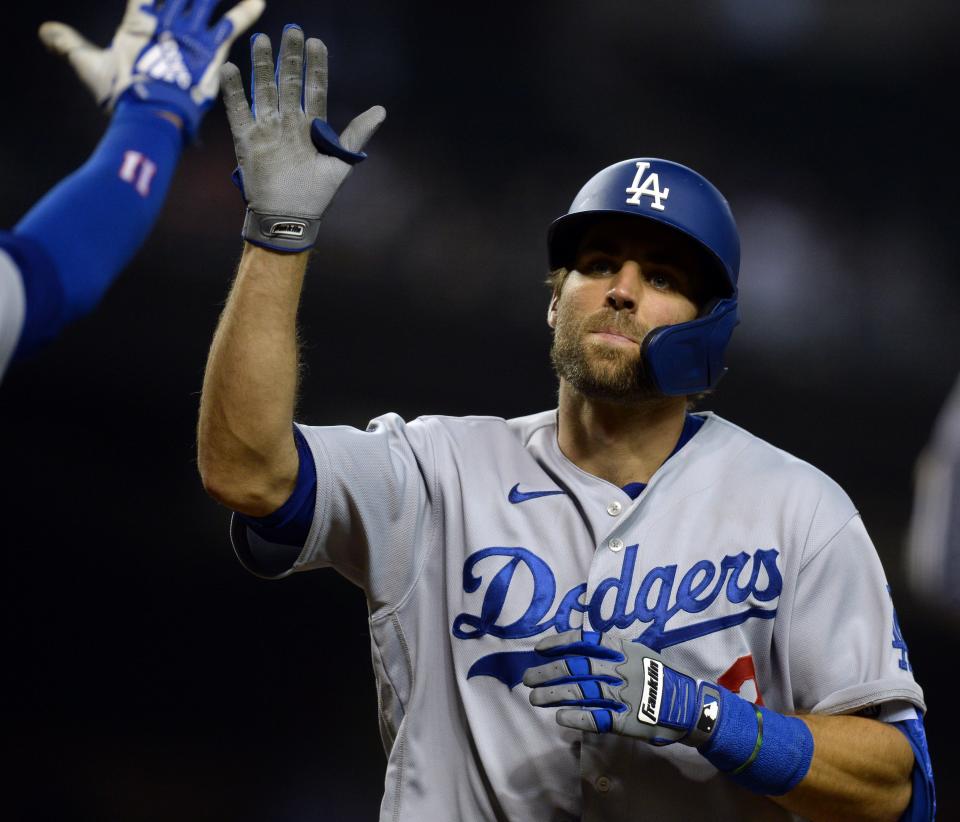Kris vs. Chris: Cubs' Bryant, Dodgers' Taylor took opposite paths, but end up selfless stars
DENVER - Kris Bryant and Chris Taylor’s career arcs at one point resembled Google stock and a troubled asset plotted on the same graph.
Bryant, after all, was baseball royalty from the jump – the No. 2 overall pick in the 2013 draft, the 2015 National League Rookie of the Year, 2016 MVP and World Series champion, endorsement king and Chicago Cub royalty. Taylor was a fifth-round pick, a fringe big league shortstop for the Seattle Mariners, a career on the majors-minors shuttle his apparent destiny.
Yet in the final season before both are eligible for free agency, their lines are intersecting, a tribute to Taylor’s persistence, Bryant’s selfless mentality and the shifting manner players are valued and deployed across Major League Baseball.
This week at Coors Field, both drank in the All-Star Game experience. It was Bryant’s fifth and possibly final appearance for the Cubs, who are probably more likely to trade him by month’s end than re-sign him in the winter.
It was Taylor’s first All-Star Game, a reward for an excellent first half but also an acknowledgment of five invaluable seasons with the Dodgers.

Bryant, though, arrives not as a third baseman but as a do-everything, play-anywhere dynamo: He’s started at least 12 games at five positions this year, including 14 in center field and 27 at third. It is a resume not typically associated with baseball royalty but rather grinders like Taylor.
But look closer.
The Dodgers have won three NL pennants and a World Series in Taylor’s five full seasons, during which he’s played 88% of their games - everywhere. He’s started at every position except first base and catcher, almost always finding himself up the middle – at second base, shortstop and center field.
While his offensive contributions are notable – a .815 OPS in that span, and the 2017 NLCS MVP award – it is on a far more visceral but highly valued level that he’s uplifted the eight-time NL West champions.
“He’s one of the biggest reasons why we’re allowed to be the Dodgers,” says All-Star first baseman Max Muncy. “He’s really a main reason why we’re as good as we are.”
That’s a nice sentiment, one echoed throughout the Dodger clubhouse, but why, pray tell, might he be placed in the same frame as Bryant?
Well, consider this: Since 2017, they are essentially the same player.
Taylor has accumulated 15.0 Wins Above Replacement since then, tied with Bryce Harper for 12th among NL position players in that span.
Bryant? He’s right behind, at 14.9.
So throw out the pedigree, for just a moment.
“Super underrated player,” Bryant says of Taylor, “on a superstar team. I’m glad he’s getting the recognition of being here for what he can do.”
It is a role Bryant himself embraced, one he says makes baseball a lot more fun in his possibly waning days in Chicago.
A well-paid 'Rover'
As an MVP, and as a long-anticipated free agent, Bryant would do well if his contractual comps are along the lines of third basemen like Anthony Rendon (who signed a $245 million deal with the Angels) Nolan Arenado ($260 million, Rockies, now a Cardinal) or Manny Machado ($300 million, Padres).
Yet Bryant will turn 30 in January and will be older than all the aforementioned players when he hits free agency. The Cubs’ much-discussed suppressing of his service time at the start of his career – a grievance filed by Bryant was denied – cost him a crucial year before hitting the market, in an era teams scrutinize age curves like a home inspector perusing a foundation.
In theory, his multi-tasking might cost him money, as well – rather than being parked at a fairly premium position, his path is not as defined.
Yet after the service-time flap, after the Cubs largely punted on this season by trading Yu Darvish and non-tendering Kyle Schwarber – both 2021 All-Stars – Bryant sounds a tone not about dollars or opportunities lost.
“I really don’t know and I don’t care, either,” he says when asked what his market may look like as a multi-position guy. “It’s just who I am: I want to play baseball like I was in club ball growing up. I wasn’t just a two hitter playing third. I’d hit fifth, I’d hit third, I’d play right, second, center.
“And that’s when it was really fun for me.”
Bryant’s dad, Mike, was the man who crafted his swing and coached many of his teams growing up in Las Vegas. When Type A parents demanded their child only play shortstop or center field, it was the future NL MVP who moved around.
“I was always the rover,” says Bryant, “because I was the coach’s kid. I’d play second. I’d play third, I’d play right. And I loved every minute of it. And it brings me back to this is why you started playing the game. Playing whiffle ball in the street, you weren’t like, ‘I’m playing third base.’ I’m like, no, I’m just going to go catch this ball. And that’s what baseball’s all about.”
And he’s proved he can still be Kris Bryant regardless of the glove on his left hand. After an injury-ravaged pandemic season, Bryant is once again banging, hitting 16 first-half home runs with an .854 OPS; his league-adjusted OPS of 133 is in line with his career norm. A strong second half, and Bryant can illustrate that his 2018 and ’20 seasons were injury-plagued outliers among his seven years of general greatness.
Bryant is earning $19.5 million in his final season of arbitration eligibility; his solid production has only enhanced the chances he’s traded.
“Now, I just realize you gotta roll with it and I’m getting so much better at it, and I’m proud of that,” he says. “Everyone here is human. You want to feel wanted. It really is a business and you don’t have much say in it. All I can do is stay focused and wake up each morning ready to play.”
Taylor has taken that MO to a higher level.

'He just does everything right'
His value and versatility can only be quantified to a certain extent. It’s clear the Dodgers want him close to the action – 70 of his 78 starts have been up the middle, including 33 in center field.
He came up a shortstop in Seattle’s system, scuffled until hopping on the elevate-celebrate swing-change train, but then the Mariners fatefully traded him to L.A. for similarly struggling pitcher Zach Lee.
With Corey Seager ensconced at shortstop, Taylor says he anticipated a future as a multi-positional guy. Yet as the years went by, it was Taylor keeping the Dodger engine purring.
Yet Seager played just 26 games in 2018 after undergoing Tommy John surgery and hip surgery, and just 37 this year after suffering a fractured hand. Cody Bellinger, the 2019 NL MVP, has been limited to 34 games this season.
Save for the two months after the Dodgers acquired Manny Machado in 2018, those absences were largely mitigated by one guy.
“There’s just not a bad thing you can say about what he does on the baseball field,” Dodgers lefty Clayton Kershaw told USA TODAY Sports. “And he’s really coming into his own. He’s kind of always been that extra guy on the bench, utility guy. And now, he’s one of our guys.
“We need him in the lineup every day. He just does everything right on the baseball field.”
As Taylor established himself as an everyday, anywhere player, his confidence soared, knowing there’s a huge difference between a guy without a position and a bench player.
It was a transition from his original vision: Everyday shortstop.
“I think most shortstops are pretty stubborn about wanting to be the shortstop and not wanting to play anywhere else. I was that way, too,” he says. “Now, I’ve kind of embraced that role, that value in being able to play all over the field.
“I think it’s one thing to be a backup and play multiple positions, but it helps to be out there every day and get the reps in. It puts you in the right headspace, knowing that you’re an everyday player as opposed to just filling in.”
And just what is such versatility and consistency and security worth?
MIDSUMMER CLASSIC: American League takes eighth straight MLB All-Star Game
BEFITTING KINGS: Guerrero & Tatis reach All-Star Game exceeding lofty expectations
Utility role, everyday salary?
Kershaw admits it’s a point of discussion in the Dodgers clubhouse: What will their beloved CT command on the open market?
Taylor will turn 31 next month, posing an interesting age vs. versatility question for general managers.
“We’ve all kind of talked about it,” says Kershaw. “There’s lots of people he can compare himself to - it’s almost like he doesn’t have to compare himself to a utility player anymore – you can pick an outfielder, pick a third baseman, second baseman, shortstop, compare him to whatever you want.
“It will be interesting to see what he gets. I hope that he does well.”
Says Muncy: “I certainly hope he gets fully appreciated, because he deserves it. And we wouldn’t be anywhere near where we are without him.”
Taylor says he hasn’t thought about market value yet, calling his first All-Star nod “humbling” while also admiring Bryant’s ability to multi-task.
“It’s not just the backup players doing it now. It’s the guys playing every day,” says Taylor.
Bryant calls Chicago “a great spot for me” and the locale for so many career and life accomplishments. His career path in Chicago has taught him not to get too invested, nor too predictive, about what’s next.
“Who knows what the future will be?” he says. “Whatever it is, I’ll be ready for it.”
This article originally appeared on USA TODAY: How Kris Bryant, Chris Taylor became selfless stars

